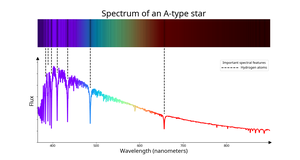Glossary term: Estrela de tipo A
Description: Uma estrela com tipo espectral "A". Os astrônomos identificam as estrelas de tipo A pela presença de fortes linhas de absorção de hidrogênio em seus espectros. Elas têm temperaturas efetivas típicas entre cerca de 7400 kelvins (K) e 10000 K. Em comparação com outras estrelas, elas parecem brancas ou branco-azuladas aos olhos humanos, a menos que sejam afetadas pelo avermelhamento interestelar ou atmosférico. Sirius, a estrela mais brilhante do céu noturno, e Vega, a estrela em relação à qual o brilho de todas as outras estrelas é medido na escala de magnitude aparente, são estrelas de tipo A.
Related Terms:
See this term in other languages
Term and definition status: The original definition of this term in English have been approved by a research astronomer and a teacher The translation of this term and its definition is still awaiting approval
The OAE Multilingual Glossary is a project of the IAU Office of Astronomy for Education (OAE) in collaboration with the IAU Office of Astronomy Outreach (OAO). The terms and definitions were chosen, written and reviewed by a collective effort from the OAE, the OAE Centers and Nodes, the OAE National Astronomy Education Coordinators (NAECs) and other volunteers. You can find a full list of credits here. All glossary terms and their definitions are released under a Creative Commons CC BY-4.0 license and should be credited to "IAU OAE".
If you notice a factual or translation error in this glossary term or definition then please get in touch.
Related Diagrams
Spectrum of an A-type star
Credit: IAU OAE/SDSS/Niall Deacon
License: CC-BY-4.0 Creative Commons Attribution 4.0 International (CC BY 4.0) icons









